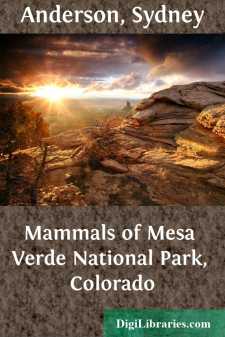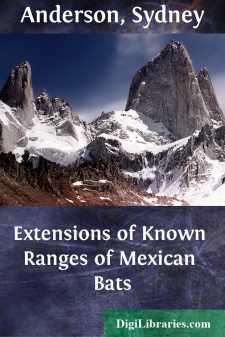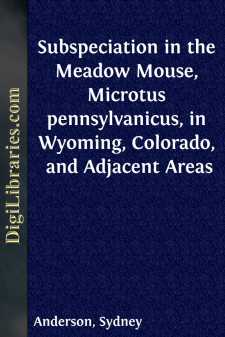Categories
- Antiques & Collectibles 13
- Architecture 36
- Art 48
- Bibles 22
- Biography & Autobiography 813
- Body, Mind & Spirit 142
- Business & Economics 28
- Children's Books 15
- Children's Fiction 12
- Computers 4
- Cooking 94
- Crafts & Hobbies 4
- Drama 346
- Education 46
- Family & Relationships 57
- Fiction 11829
- Games 19
- Gardening 17
- Health & Fitness 34
- History 1377
- House & Home 1
- Humor 147
- Juvenile Fiction 1873
- Juvenile Nonfiction 202
- Language Arts & Disciplines 88
- Law 16
- Literary Collections 686
- Literary Criticism 179
- Mathematics 13
- Medical 41
- Music 40
- Nature 179
- Non-Classifiable 1768
- Performing Arts 7
- Periodicals 1453
- Philosophy 64
- Photography 2
- Poetry 896
- Political Science 203
- Psychology 42
- Reference 154
- Religion 513
- Science 126
- Self-Help 84
- Social Science 81
- Sports & Recreation 34
- Study Aids 3
- Technology & Engineering 59
- Transportation 23
- Travel 463
- True Crime 29
Records of Harvest Mice, Reithrodontomys, from Central America, with Description of a New Subspecies from Nicaragua
by: Sydney Anderson
Description:
Excerpt
Since 1952 when Hooper's review of Latin American harvest mice was published, collectors from the Museum of Natural History of the University of Kansas have visited several countries in Central America, and have obtained many additional specimens. Among these we find a new subspecies of Reithrodontomys fulvescens from Nicaragua, significant extensions of known geographic range for several other species, and additional information on variation in some little known kinds. Specimens in the Museum of Natural History of Reithrodontomys mexicanus cherriei, Reithrodontomys tenuirostris, and Reithrodontomys creper that are from within the geographic and altitudinal ranges listed by Hooper (1952) are not included in this report.
All place names are on the map of Hispanic America published by the American Geographical Society and can be located by consulting the "Index to map of Hispanic America" (Vol. 1, Geographical names in Central America, U. S. Government Printing Office, Washington, D. C., 1943.) All measurements cited are in millimeters.
Support for field work was provided by the Kansas University Endowment Association. Support for the laboratory phases of the work came in part from a grant from the National Science Foundation. Most of the specimens herein reported were collected by James W. Bee in late 1954 and early 1955, and by J. R. Alcorn and A. A. Alcorn in 1955 and 1956. A few that were collected earlier by other persons are mentioned. We are indebted to the following individuals for the loan of specimens in their care: R. G. Van Gelder, American Museum of Natural History; Philip Hershkovitz, Chicago Natural History Museum; W. H. Burt and E. T. Hooper, Museum of Zoology, University of Michigan; and D. H. Johnson and C. O. Handley, Jr., U. S. National Museum.
Reithrodontomys sumichrasti australis J. A. Allen.—Seven specimens from the vicinity of Volcan Irazú, Cartago, Costa Rica, are from within the geographic and altitudinal range recorded for the subspecies by Hooper (1952:82).
One female, KU 26967, trapped on March 2, 1947, on the SW slope of Volcan Irazú, 8500 ft., contained five embryos that were 17 mm. in crown-rump length.
Reithrodontomys sumichrasti dorsalis Merriam.—A total of 93 females are among 195 specimens from 24 localities in Guatemala that lie within the geographic and altitudinal range recorded by Hooper (1952:78) for dorsalis.
Two females were pregnant; KU 71363, taken on January 28, 1956, 7 mi. E, 2 mi. S La Unión, Quetzaltenango, Guatemala, contained three embryos that were 7 mm. in crown-rump length, and KU 65245, taken on December 15, 1954, 1 mi. NE Nebaj, 6000 ft., El Quiche, Guatemala, contained four embryos that were 15 mm. in crown-rump length. These two females were the only pregnant ones among 36 taken in December, 23 in January, 1 in February, 19 in March, 5 in April, and 9 in August.
Reithrodontomys fulvescens chiapensis Howell.—Guatemala.—Baja Verapaz: 1/2 mi. N, 1 mi. E Salamá, 3200 ft., 1 (KU 65378—January 28, 1955); 1 mi. S Rabinal, 3450 ft., 4 (KU 65379-82—January 29, 1955); 5 mi. N, 1 mi. W [Santa Cruz] El Chol, 6000 ft., 1 (KU 65375—January 30, 1955). Guatemala: 5 mi. S Guatemala City, 4950 ft., 2 (KU 65371-72—March 13, 1955); 7 mi. S, 6 mi. E Guatemala City, 5800 ft., 1 (KU 65370—March 14, 1955). Santa Rosa: 2 mi. N, 2 mi. W Cuilapa [= Cuajiniquilapa], 2980 ft, 2 (KU 65376-77—March 5, 1955).
The specimens from the departments of Guatemala and Santa Rosa are from localities that lie on the Pacific slope and are southwest of the previously known range of the species (see Hooper, 1952:93). The specimens from 1/2 mi. N and 1 mi. E Salamá and from 1 mi. S Rabinal are paler dorsally than other Guatemalan specimens available to us, including the specimen from the nearby locality, 5 mi....








